The Art of Picture Hanging: Finding the Perfect Height
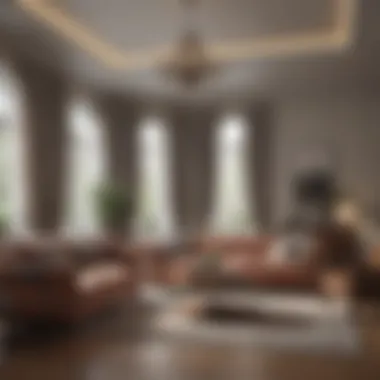
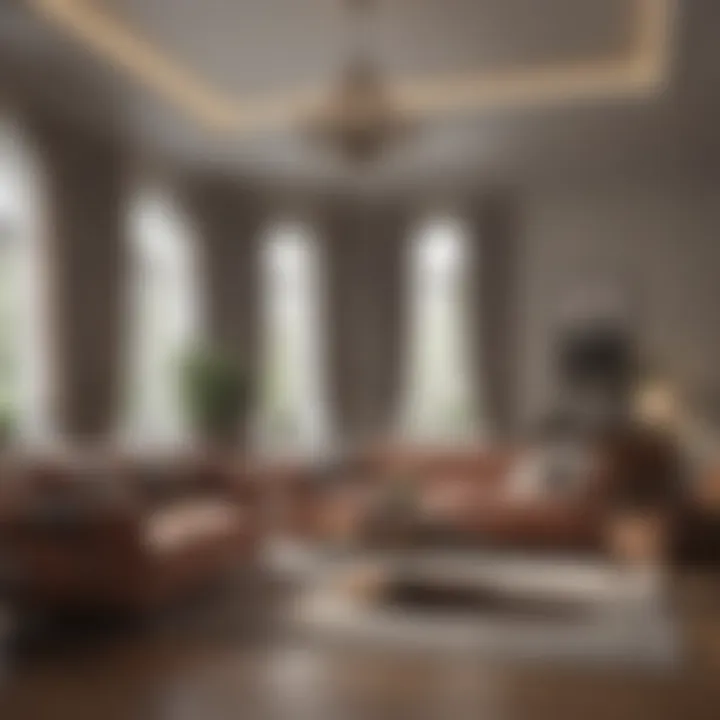
Intro
This section will discuss the key components that influence how and where you should hang your pictures to create visually appealing displays. Understanding the science behind placement can enhance the aesthetic quality of your living spaces.
Featured Homes
In modern homes, interior design varies widely. From open concept to traditional layouts, each style offers unique opportunities for picture placement. The heights at which art is displayed can significantly affect the perceived atmosphere of the room.
Architectural Highlights
Consider a home with high ceilings. In such spaces, placing pictures too low can lead to visual discordance. Instead, art should be elevated, possibly at eye level or slightly above. This draws the eye upward, enhancing the feeling of openness. In contrast, in homes with lower ceilings, artwork should be closer to the viewer. This leads to a warm and intimate atmosphere.
Interior Design Themes
Different interior design themes call for varied approaches to picture hanging. Minimalist designs thrive on simplicity. Artwork should typically be hung at the 57 to 60-inch mark from the floor to the center of the piece. In contrast, in a gallery wall setting, the rules can be more relaxed, with varying heights adding interest and a sense of depth.
The Psychology of Height
It’s essential to consider how people interact visually with art. Viewers often feel more connected to artwork that is placed at eye level. When art is too high, it can alienate the observer, creating a feeling of disconnection. This psychological element can greatly impact the overall enjoyment of art in a home environment.
"Art is not what you see, but what you make others see." - Edgar Degas
Viewing Angles and Spaces
The context of the room plays a significant role in determining picture height. For gallery arrangements, integrating furniture like sofas or chairs can create a more engaging experience. When seated, individuals should be able to view art comfortably without straining. Therefore, hanging art a few inches above eye level when standing can provide a balanced visual impact.
Epilogue
In summary, hanging pictures at the right height is a delicate balance of artistic expression and psychological engagement. By understanding and applying these principles, you can cultivate an atmosphere that complements both the artwork and the space, achieving a harmonious wall display.
Foreword to Picture Hanging Standards
Hanging pictures at the right height is critical for creating a visually appealing environment. The standard height for displaying artwork is not just about aesthetics; it also involves factors like human perception, the arrangement of furniture, and the overall purpose of the space. Understanding these standards can lead to more harmonious interiors that enhance mood and usability.
Importance of Correct Height
The correct height for hanging pictures can transform a room. An artwork placed too high can create a disconnect, while one hung too low may overwhelm the space. Properly hung pictures invite viewers into a balanced view where art and surroundings coexist seamlessly. This positioning affects not only the visual experience but also the emotions felt while in the space. Research indicates that well-placed art can lead to increased enjoyment and satisfaction with one's environment.
General Guidelines
When considering where to place your pictures, there are a few general guidelines to follow. Many interior design experts recommend hanging artwork so that the center of the piece is approximately 57 to 60 inches from the ground. This height aligns with the average eye level for most adults. However, other factors can adjust this measurement, depending on the room's purpose and the viewer's eye level.
- Consider the Type of Art: Large pieces, such as paintings or photographs, may require different considerations compared to smaller prints or framed artwork.
- Think About the Furniture: If a piece of furniture is directly below the artwork, ensure there is enough space above it to create an inviting visual flow. A good rule is to leave about 6 to 12 inches between the top of the furniture and the bottom of the artwork.
- Account for Ceiling Height: In rooms with higher ceilings, you may want to position art slightly higher than the standard recommendation to maintain proportion.
By adhering to these essential guidelines, the resultant atmosphere nurtures a connection between art and its surroundings, which can elevate any space.
Principles of Visual Aesthetics
Visual aesthetics are critical in determining how artwork interacts with a space. Understanding these principles can enhance the overall ambiance of a room. Aesthetics consider how art complements or contrasts with its environment. This awareness aids in making informed choices that can elevate the emotional and visual impact of a room.
The Rule of Thumb
One commonly referenced guideline in the world of art placement is the rule of thumb. This guideline suggests hanging artwork at 57 to 60 inches from the floor to the center of the piece. This height aligns with the average eye level of most people, making the artwork easily observable. It's a simple yet effective way to ensure your art doesn't go unnoticed.
The effectiveness of this rule lies in its balance. When the art is at this height, it avoids being too high to appreciate or too low to capture attention fully. Adhering to this rule can lead to a more visually appealing arrangement.
Eye Level Considerations
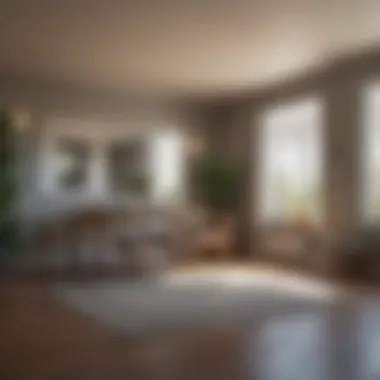
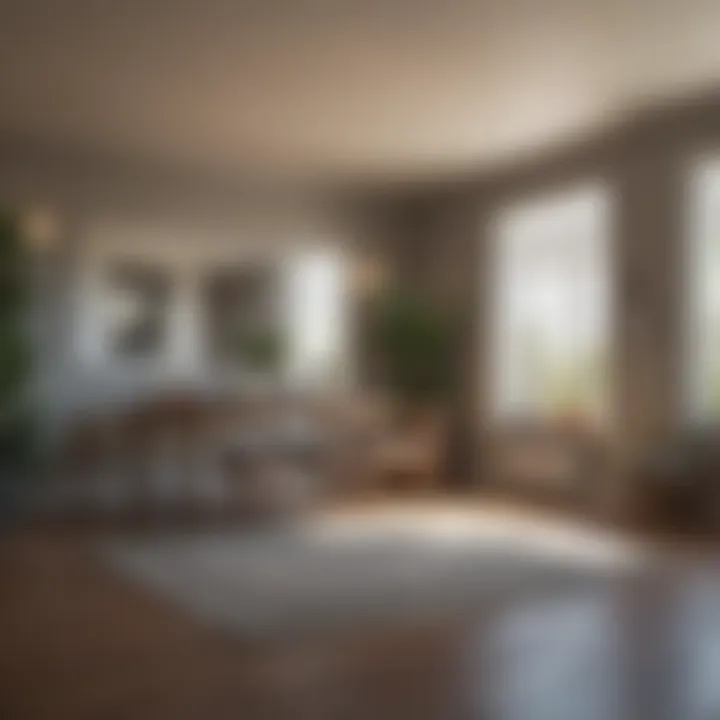
When discussing eye level, one must consider different heights based on the audience. For instance, children's art may require lower placements to be appreciated fully by younger viewers. On the other hand, art displayed in a formal setting may be more effective if aligned with the average adult eye level.
Furthermore, various activities in a space can also influence eye level decisions. In a casual living room, eye level can shift based on the furniture arrangement, such as whether guests sit or stand. Thus, it is essential to adapt your hanging heights based on the primary function of the room and the type of viewers expected.
"Art that resonates often speaks from the eye level of its intended audience."
In summary, visual aesthetics related to picture hanging is not merely about placement. It involves understanding your environment, audience, and the emotional responses you wish to elicit through your art. Taking these principles into account will foster a more engaging and harmonious visual narrative within your chosen space.
Factors Influencing Picture Height
When it comes to hanging pictures, several elements determine the most visually effective placement. Understanding these factors can significantly enhance the overall aesthetic and functionality of a space. Optimal picture height cannot be decided in isolation; rather, it interacts with environmental variables such as room dimensions, furniture positioning, and the characteristics of the artwork itself.
Room Size and Ceiling Height
Room size and ceiling height play a crucial role in deciding how high pictures should be hung. In smaller rooms, hanging pictures lower can create a more intimate feel, fostering a warm and cozy atmosphere. Conversely, in larger spaces, positioning artwork higher on the wall can help to draw the eye upward, making the room feel even more spacious than it is.
Also, rooms with high ceilings allow for more creative placement options. Elevated artwork can balance proportions, creating a pleasing contrast with lower furniture. Too low hanging may cause pieces to feel lost against vast wall spaces. Thus, the aim should be to find a balance that feels cohesive and integrated with the overall room dynamics.
Furniture Layout
The layout of furniture significantly influences where pictures look best. Artworks should relate to their surroundings. For example, pictures above a sofa or console table should be centered and aligned with these pieces to create a unified look. If a picture is too high or low relative to the furniture, it can disrupt the visual flow, leading to a disjointed look.
Furthermore, consider how people interact with furniture in the room. If a piece is often used, like a dining table, the artwork should avoid being too low, as this may obstruct views. Paying attention to these interactions ensures that the placement enhances both aesthetic appeal and practicality.
Artwork Size and Style
The characteristics of the artwork itself cannot be overlooked. Both size and style contribute to determining its ideal hanging height. Larger pieces tend to command attention and may be best displayed at eye level or slightly above. Smaller artworks can be grouped together or positioned higher up, creating an appealing gallery effect.
Styles also shift the dynamics of height. For instance, abstract pieces may lend themselves to higher placements, while realistic paintings might create a stronger impact when hung lower, inviting closer observation. Thus, understanding the unique qualities of each artwork is essential for making informed decisions about placement.
Psychological Impact of Artwork Placement
Artwork placement in interior design transcends mere aesthetics; it engages viewers on an emotional level. Understanding the psychological impact of where art is hung can elevate a space from ordinary to exceptional. This section explores how the height of artwork can affect mood, perception of space, and overall ambiance.
Emotional Responses to Height
The height at which pictures are hung can significantly affect emotional responses. When art is displayed at eye level, it fosters connection. Viewers feel they can engage with the work, crafting a personal bond with the art. This height facilitates accessibility to emotions and ideas conveyed by the piece. Conversely, artwork placed excessively high may create feelings of detachment. Viewers could feel disconnected from the art, which diminishes its impact.
Research shows that familiarity and comfort lead to positive emotional responses. For instance, a child's drawing may elicit joy when displayed at their height. Thus, a thoughtful consideration of height is crucial. Ideal height for most artworks is approximately 57 to 60 inches from the floor. This height aligns closely with the average eye level of adults, optimizing visual engagement.
Creating Harmony in the Space
Harmony in a space is achieved through careful consideration of layout and artwork placement. When artwork is hung thoughtfully, it complements the surrounding environment, creating a cohesive aesthetic. Conversely, haphazard placement can lead to visual chaos.
To achieve harmony, consider the following factors:
- Proximity to Furniture: Artwork should relate to furniture and architectural elements. Hung too high above a sofa, it feels out of place. Keep artwork close to seating arrangements to enhance the sense of connection.
- Color Coordination: Colors in the artwork should resonate with the space's color palette. This alignment encourages a flow that is pleasing to the eye.
- Theme Consistency: Aligning artwork with the room's theme helps achieve harmony. A modern piece in a traditional setting may disrupt the flow.
Art is most impactful when displayed with consideration of its surroundings.
In summary, the psychological impact of artwork placement pertains to emotional responses and visual harmony in the space. Recognizing these elements can transform an area, making it more inviting and coherent. By paying attention to height, artwork can be more than decoration; it becomes a crucial aspect of environmental enhancement.
Measuring Techniques for Accuracy
Accurate measurement is crucial when it comes to hanging pictures. Properly determining the height and placement of artwork can significantly enhance the aesthetic appeal of a room. This section aims to delve into the specific techniques that can aid in achieving precision when positioning your artwork on walls. Whether one is aiming to avoid awkward heights or create a cohesive look across multiple pieces, understanding measuring techniques is indispensable.
Using a Measuring Tape
A measuring tape is perhaps the most straightforward tool for ensuring accurate picture placement. While this tool seems simple, its effectiveness is remarkable. Start by measuring the height of the wall where the artwork will hang. Then, divide this height by two to find the midpoint. This midpoint serves as a key reference, especially if you’re hanging multiple pieces in alignment.


To find the ideal height for your artwork, measure from the floor to this midpoint. For standard display, the center of the artwork should ideally be about 57 to 60 inches from the floor. This height accommodates an average person's viewing angle and is generally pleasing for most spaces.
Incorporating Visual Tools
In conjunction with traditional measuring techniques, visual tools can enhance accuracy and provide a clearer perspective on how a piece will look once hung. Utilizing resources such as laser levels or spirit levels can help achieve straight lines and avoid skewed placements. Position the laser level at the intended hanging height and ensure that the artwork aligns with this line. This approach is particularly beneficial when hanging multiple pieces symmetrically or in a gallery-style arrangement.
Moreover, templates made from butcher paper or cardboard can be beneficial. Cut out shapes that mirror the dimensions of the artworks you plan to hang, and tape them to the wall. This method allows you to visualize spacing and placement before making any permanent decisions. It helps in preventing errors and potential regrets regarding height and alignment.
An effective measurement strategy can transform the look of a room, making art placement appear effortless and intentional.
Common Mistakes in Picture Hanging
Understanding common mistakes when hanging pictures is vital for achieving a pleasing visual arrangement. Even minor errors can lead to frustration and dissatisfaction with the overall look of a space. By being aware of these pitfalls, individuals can ensure that their artwork displays are both harmonious and effective.
Hanging Too High or Too Low
One prevalent mistake in picture hanging is positioning artwork at incorrect heights. Often, people tend to hang pictures too high, leading to a display that feels disconnected from the room. Conversely, hanging pictures too low can result in a cluttered look and obstruct views. The preferred standard height for artwork is approximately 57 to 60 inches from the floor to the center of the piece. This measurement aligns with eye level for most viewers, allowing art to be appreciated fully.
In common living spaces, such as living rooms or dining areas, this standard can contribute to a balanced aesthetic. When art is adequately placed, it creates a pleasant visual flow and invites guests to engage with the artwork. When hung properly, art pieces can become focal points in a design setting.
Ignoring Viewing Angles
Another critical misstep is neglecting viewing angles. When one displays art, they often overlook how different perspectives can alter the visual impact of a piece. For instance, art that looks splendid from a seated position may not resonate the same from a standing angle. Understanding the viewing conditions is crucial for any room layout.
To avoid this mistake, take into consideration how the art will be viewed from various points in the room. One effective technique is to measure the height at which viewers typically see the art when seated or standing. Check the same artwork from different areas in the room, noting how its placement influences the overall aesthetics and emotional response.
"Art should be a dialogue with the environment, not a soliloquy in isolation."
Pay close attention to how the accompanying furniture and layout affect the visibility. An ideal arrangement balances artwork with surrounding elements without overwhelming the viewer. Keeping these aspects in mind helps secure a satisfying display that complements both the art and the setting.
Alternatives to Standard Height
When considering the placement of artwork in a space, it is essential to recognize that adherence to a strict standard height may not always yield the desirable aesthetic outcomes. The movement towards alternatives to traditional height recommendations can transform a mundane wall into a focal point of interest. This section delves into the concept of flexibility in art placement, examining the various approaches that can tailor a space to reflect personal taste and functionality.
Gallery Walls
Gallery walls have become increasingly popular in interior design. This trend involves grouping multiple pieces of art together in a cohesive manner. Unlike individual pieces hung at a specific height, gallery walls allow for greater freedom. Artwork can be arranged close together, filling a defined area of a wall without the constraint of height norms.
When creating a gallery wall, there are several factors to consider:
- Theme Consistency: Art pieces should share a common theme or color scheme for visual harmony.
- Variety of Sizes: Incorporating different sizes adds interest and creates a dynamic arrangement.
- Framing: Uniform framing can unify disparate pieces, while varied frames can add character.
One important aspect is to maintain a balance in spacing. Adequate distance between pieces enhances viewing pleasure. Ideally, spacing should be 2 to 5 inches between frames to avoid cluttering.
"A well-executed gallery wall transforms empty space into a curated collection that tells a story."
Layering Art Pieces
Layering art pieces introduces depth and complexity to wall displays. This approach involves overlapping pieces, either by hanging them slightly off-center or placing smaller pieces in front of larger ones. Layering can effectively utilize vertical space that may otherwise go unnoticed. It allows individuals to showcase more of their collection without overwhelming a wall.
Consider the following when layering:
- Visual Hierarchy: Place larger pieces at the back and smaller ones in front to create depth.
- Consider Texture: Mixing 2D art with 3D objects, like sculptural items or textiles, can add tactile interest.
- Changeable Displays: Layered artworks can be easily rearranged, offering continued exploration and creativity.
In summary, both gallery walls and layering techniques offer significant freedom in the art placement process. By moving away from standard height measures, individuals can infuse their personalities into their spaces, making their environments more engaging and reflective of their aesthetic choices.
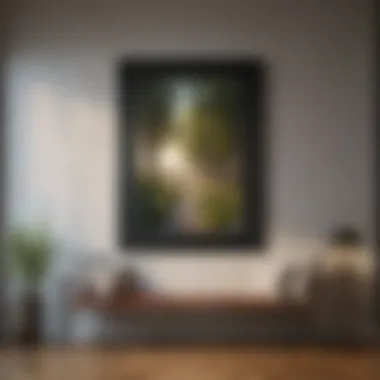

Special Considerations for Different Spaces
Hanging pictures is not a one-size-fits-all task. Each room presents distinct challenges and opportunities concerning the placement of artwork. Understanding these special considerations leads to a more effective presentation of art and enhances the overall aesthetic appeal of a home. Knowing how the purpose and layout of each space can affect picture placement is critical in achieving a cohesive look throughout the home.
Hanging in Living Rooms
The living room serves as a central gathering place, embodying both comfort and style. When hanging pictures in this space, consider the height at which art is displayed. Typically, the center of the artwork should align approximately with the average eye level of seated guests, which is around 56 to 60 inches from the floor. This placement allows viewers to engage with the piece comfortably and appreciate its details.
Moreover, the arrangement of furniture plays a crucial role. Art should complement the furnishings and any architectural features. Grouping pictures can create a gallery effect, drawing attention and making the room feel welcoming. Additionally, choosing pieces that resonate with the room's theme can enhance style and emotional atmosphere.
Considerations for Hallways
Hallways often serve as transitional spaces, yet they also provide great opportunities for artwork. The key consideration here is lighting. Many hallways may have limited natural light, so opt for lighter frames or vibrant images to make the space feel more open and inviting. Since people usually walk through hallways quickly, art placement should be lower, around 48 to 54 inches, allowing for a quick glance.
Using a series of smaller pieces creates rhythm and draws the eye down the hall. Ensure that there is enough clearance from furniture or other obstacles to prevent interference with the flow. In contrast, a single statement piece can create a striking focal point, especially in narrow hallways where space is limited.
Art Placement in Bathrooms
Bathroom spaces require special considerations due to humidity and lighting. It is essential to use moisture-resistant frames and materials. Consider placing artwork 52 to 56 inches above the floor, which is slightly lower than in other spaces. This height can contribute to a relaxing and cozy atmosphere.
Since bathrooms are often smaller, smaller framed pieces work best to prevent overwhelming the space. Abstract prints or serene landscapes can contribute to a soothing ambiance. Avoid placing art directly above the sink where water or steam might damage it. Instead, install it on a wall that receives less direct moisture but still allows it to be appreciated.
Art placement varies by space. Consider visuals, height, and humidity factors for an effective display.
By taking into account the unique characteristics of each room, you can create thoughtful and visually appealing arrangements that complement your home’s design while enhancing its livability.
Practical Tips for Effective Hanging
Hanging pictures may seem like a straightforward task, yet many oftentimes overlook practical considerations that can impact the final result. By adhering to certain practical tips, one can achieve a display that is not only aesthetic but also practical. The height, alignment, and support for each piece play crucial roles in the overall visual experience. These aspects contribute significantly to how art engages with the space around it, creating an environment that feels cohesive and well-planned.
Using Anchors and Hooks
When hanging artwork, it is essential to use the correct hardware for support. Anchors and hooks provide stability and ensure that the artwork remains securely in place. For heavier pieces, wall anchors are particularly important. They distribute the weight across a larger surface area of the wall, reducing the risk of damage or falling.
- Types of Anchors: If you are working with drywall, toggle bolts and screw-in anchors are often very effective. For brick or concrete, masonry screws can do the job well. Each type serves a different purpose and should be chosen based on the material of the wall.
- Weight Distribution: Be sure to consider the weight of the art when selecting hardware. Using multiple hooks or anchors can enhance stability, particularly with larger frames.
Installing the right hardware not only supports the artwork but also allows it to be displayed at the correct height. Always read the manufacturer's specifications regarding weight limits to ensure your art is secure.
Adjusting Height Post-Hanging
Even after calculating the ideal height for a piece, there is often a need for adjustments. Factors like lighting, the surrounding decor, and the viewer's perspective can influence the perceived height of an artwork. It can be tempting to leave items at their initial height, but minor adjustments can substantially refine the overall look.
- Assessing Final Height: Stand back and review how the piece interacts with both furniture and your overall layout. If it appears too low or too high based on the surrounding context, don’t hesitate to reposition it.
- Technique for Adjustment: To make adjustments easier post-hanging, consider marking the wall lightly with pencil to indicate original and new heights. This practice ensures that you can replicate your final visions accurately without repeated trial and error.
- Feedback from Others: It can also be beneficial to seek a second opinion. Fresh eyes may notice out-of-place alignments that you did not perceive.
Overall, practical tips are important in achieving effective hanging. Understanding and applying these methods not only elevate the look of your artworks but also provide the peace of mind that comes with security and stability.
End and Final Recommendations
Reviewing the Key Points
Throughout this article, various factors have emerged as significant when determining the appropriate height for hanging pictures. Here are the main points:
- Standard Height: A commonly accepted standard is hanging pictures at eye level, approximately 57 to 60 inches from the floor to the center of the piece.
- Visual Aesthetics: The placement should consider the proportions of the room, wall, and surrounding furniture.
- Psychological Effects: Artwork at an appropriate height can evoke emotional responses and promote harmony within the space.
- Practical Techniques: Employing measuring tools and visual aids can help achieve the desired look.
- Common Mistakes: Avoid frequent errors like hanging artwork too high or neglecting viewing angles, which may detract from the intended effect.
These considerations collectively inform effective hanging practices that lead to visually appealing and psychologically uplifting interior environments.
Encouraging Personal Expression
While guidelines serve as a useful starting point, personal expression remains central to the art of displaying pictures. Every individual has unique tastes, styles, and preferences. It is important to move beyond standardized heights to create a space that reflects one’s personality and resonates with personal experiences.
- Experimentation: Feel free to adjust the height based on your comfort and the emotional impact of the artwork. Each location in your home could have a different approach, depending on its function and ambience.
- Group Displays: In galleries or multi-piece setups, consider how various elements work together. Creating layers can enhance storytelling through visual art.
- Personal Attachment: Place artworks in locations that evoke specific memories or meanings. This practice will not only enhance the visual experience but also transform your space into a narrative of your life.
Ultimately, the pursuit of beauty in your living space is singular and personal. Balancing guidelines with creativity enables anyone to create an environment that is both aesthetically pleasing and deeply meaningful.







